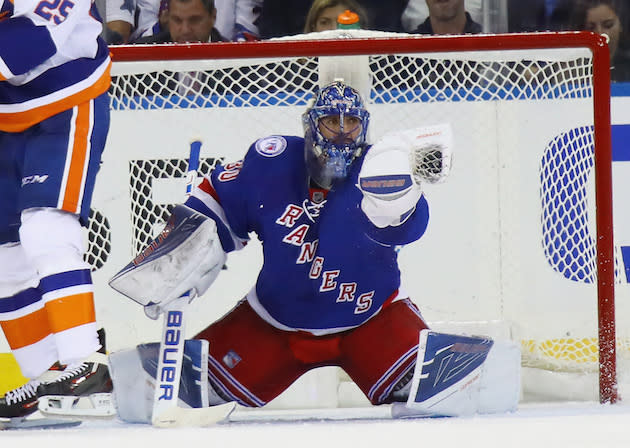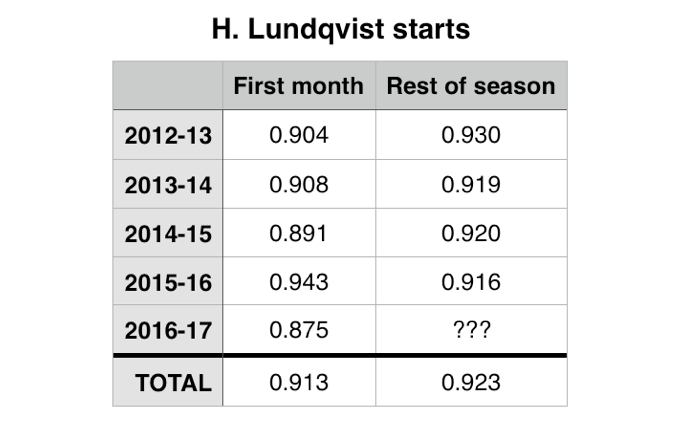Why does Henrik Lundqvist start slow? (Trending Topics)

It was hard not to notice Henrik Lundqvist having another rough outing on Wednesday night. Bad giveaway for a goal, yeah, but also stopping just 16 of 18 overall isn’t very good.
And hey, bad performances happen to even the best goalies on earth. They’ve been a little more common than the New York Rangers might like so far in this (extremely) young season, but you roll with it a little bit and hopefully things work out for you long-term. Certainly, expecting Lundqvist to stay below .900 on his save percentage is a fool’s errand, but on some level, you don’t like to see a team expected to have a decent amount of problems squandering what has been a solid start to the season, possession-wise.
[Join a Yahoo Daily Fantasy Hockey contest now]
Put another way, if some told you two weeks ago the Rangers were going to start 2-2-0, you would have had to display some real psychic abilities to say, “Because Lundqvist blew it, right?”
But what’s interesting is that Lundqvist is routinely pretty bad to start the season these days. Ever since the lockout-shortened season a few years back, he’s been a slow starter who figures it out pretty quickly.
There may be a lot of reasons why this is the case. At nearly 35 years old, Lundqvist is now clearly on the downswing in his career, age-wise. He just doesn’t have a lot of good years left, in theory. (Lundqvist might also be one of those guys who lasts forever because he’s still an elite-level goalie into his mid-30s; even if he declines over the next two or three years, doesn’t he simply become league-average?) But with age, maybe it just takes him a little longer to get the motor running at full speed? To continue the car analogy: He runs just fine, but it takes him a little longer to go from zero to 60.

That tells a little bit of a story, even accounting for the white-hot start last season, because it’s over thousands of shots faced. Four of the past five seasons, his first month has been putrid by any standard, let alone his own extremely high one. Supporting the age theory is that his season starts were typically at least a little above average, and often well above it, prior to the 2012-13 lockout. Perhaps it’s not a coincidence, then, that the 2013 season was also the one in which he turned 30.
But also, maybe it is.
Because looking at the data, there’s not really a lot of other indications that the Rangers play significantly worse in front of him when these seasons start out. He doesn’t face a significantly higher number of high-danger shots over the five-year period. And even, say, last season when his save percentage skyrocketed in October, it wasn’t because the shot quality he was facing changed very much.

The only real difference here is that there’s a decent-sized uptick in the share of shots he’s seeing at medium versus low quality. There’s also a very slight increase in the frequency of high-danger shots. That should push his save percentage downward somewhat, for sure, but not so significantly as to swing his overall number by 10 points.
And what’s interesting is that his save percentage actually goes up on medium-quality shots in the first month of the year, while the two save rates on low- and high-quality shots take major hits.

So we’ve figured out why his save percentage dips overall: He has a little more trouble stopping shots from the outside, for any number of reasons, and also teams are beating him far more often from in close. Is there anything to explain that change? In theory, it’s possible.
We know, for example, that shots on goal generated on rushes or rebounds are, for obvious reasons, generally going to result in larger numbers of goals. When teams counterattack, or can create chaos around the net, that tends to result in guys not being covered and wide open nets. Stands to reason, then, that the Rangers — with their porous defense — might be a little more scrambled in their coverage schemes at the beginning of the year. And yet, that’s not the case. As a percentage of the total number of shots he faces, Lundqvist actually sees fewer rushes and rebounds in the first month of the season than later in the year.
Another possible cause I considered but quickly dismissed: More road dates? There was the slow start in 2013-14 (Lundqvist went .908 and 3-5-0) as the Rangers played his first seven starts on the road, but that was the only season in which such a long stretch was observed. Overall, he played only 10 of his 23 other first-month appearances away from Madison Square Garden. The home/road splits over that time aren’t all that telling here either. Lundqvist tends to be very slightly better on the road overall anyway.
The obvious answer here, then, is one that isn’t likely to satisfy anyone: It’s probably a luck thing. Random variance. Even across all these appearances, Lundqvist only faced a little more than 1,000 shots of all quality in the first month of the season over the past five years. That’s in comparison with more than 7,100 in all other months. So the goals he does allow are going to stand out more, especially on, say, low-percentage shots. Or when he gives the puck away from behind his own net. Just to pick a random example of how something could go wrong.
Given the quality of the defenders in front of him, maybe this year the Rangers would like him to snap out of it, say, nowish. Odds don’t seem great that they keep the success in possession up for all that much longer. The good news is that Lundqvist’s struggles do seem to go away, apparently on their own. However he gets up to speed by himself — not unlike Jarome Iginla, another famously slow starter — he seems to do it pretty consistently.
The thing is, though, that the margin for error this year is probably a lot slimmer than it used to be. Where the Rangers used to comfortably make the playoffs every spring, that’s not looking like such a sure thing any more. If they miss by three or four points, maybe we point to Lundqvist’s slow starts as a reason why. Then again, since he’s usually the reason they make the playoffs so comfortably in the first place, maybe we cut him some slack regardless.
Ryan Lambert is a Puck Daddy columnist. His email is here and his Twitter is here.
(All statistics via Corsica unless otherwise noted.)

 Yahoo Nachrichten
Yahoo Nachrichten 


